This trailer dolly is built using parts available at Princess Auto (in Canada) and probably Harbour Freight in the US.
Parts list:
- 2000 lb ATV winch
- 16 tooth #40 drive gear
- 54 tooth #40 driven gear
- 3/4″ keyed drive axle
- 2- 3/4″ pillow block bearings
- Hitch ball
- Wheels & hub that key to axle
- Keyed hubs for gears
- Pivot wheel (make sure it will carry the weight
- Metal for frame
The frame is built from some scrap 3″x4″x 3/8″ thick aluminum angle and some 1.5″x3″x1/8″ aluminum channel. The frame is bolted together.
The handle was salvaged from an old lawn mower. Power is provided through the trailer plug directly from the trailer battery, alternatively the alligator clips can be attached to the vehicle battery. Plug connectors allow for the use of a 10/3 extension cord to extend the power cord if needed. A momentary rocker switch on the control activates the trailer brakes, although the planetary gears on the winch motor seem to prevent a runaway situation.
Cable drum on winch needs to be machined down to fit drive gear hub.
Tow ball is quick release and can be changed
Showing both 1 7/8″ and 2″ balls
Trailer wire connector
Electrical adapters for using vehicle battery
Controller, black rocker switch applies trailer brakes
The following images were a request in the comments for picture of the under side and measurements.



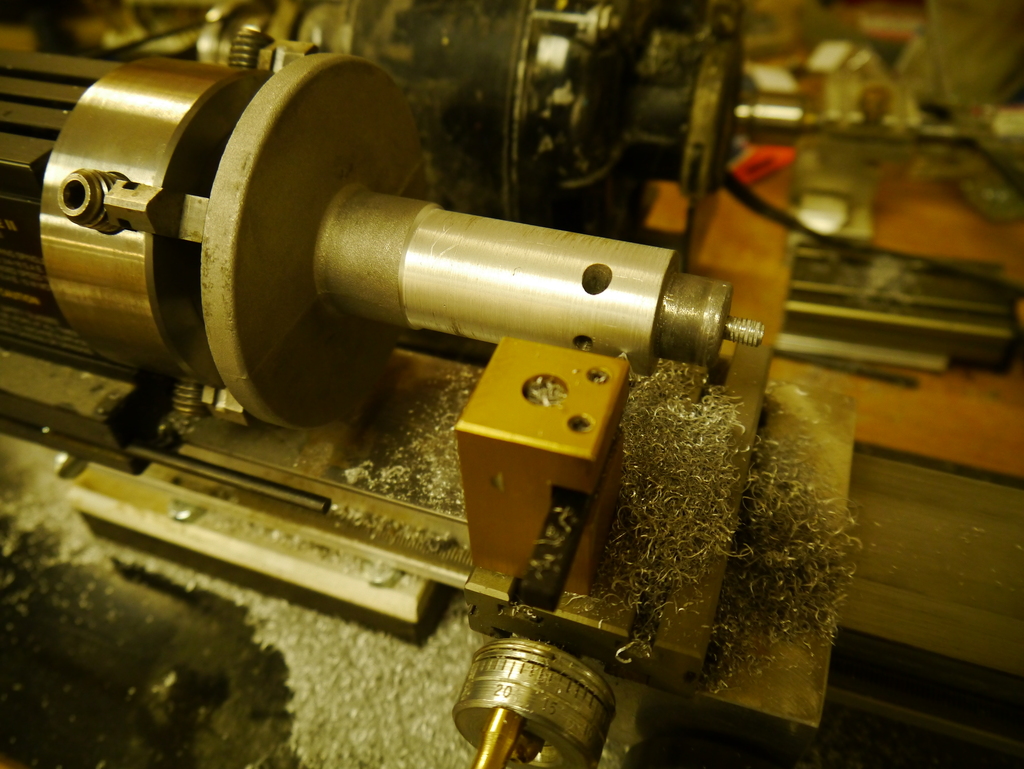
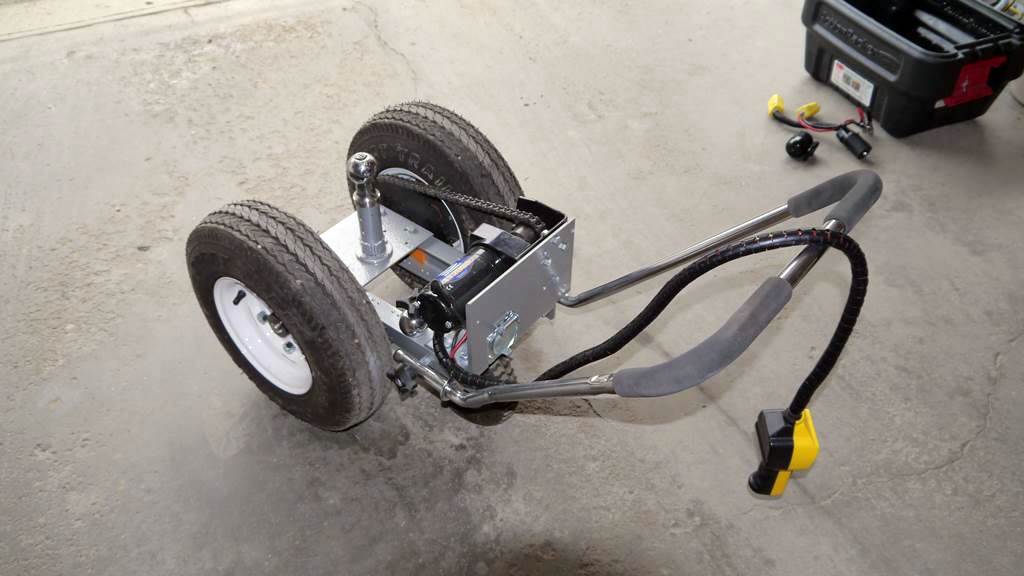
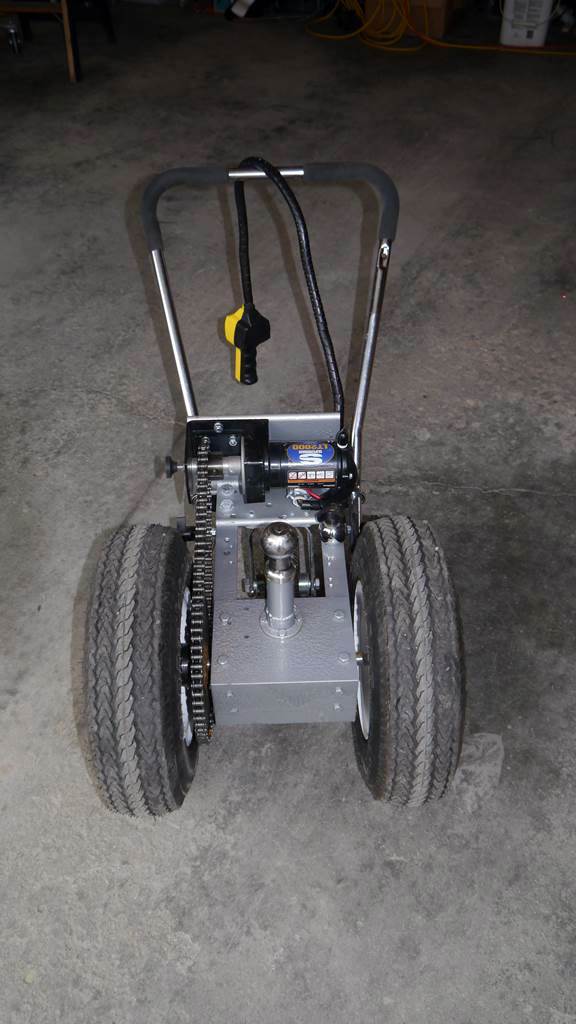
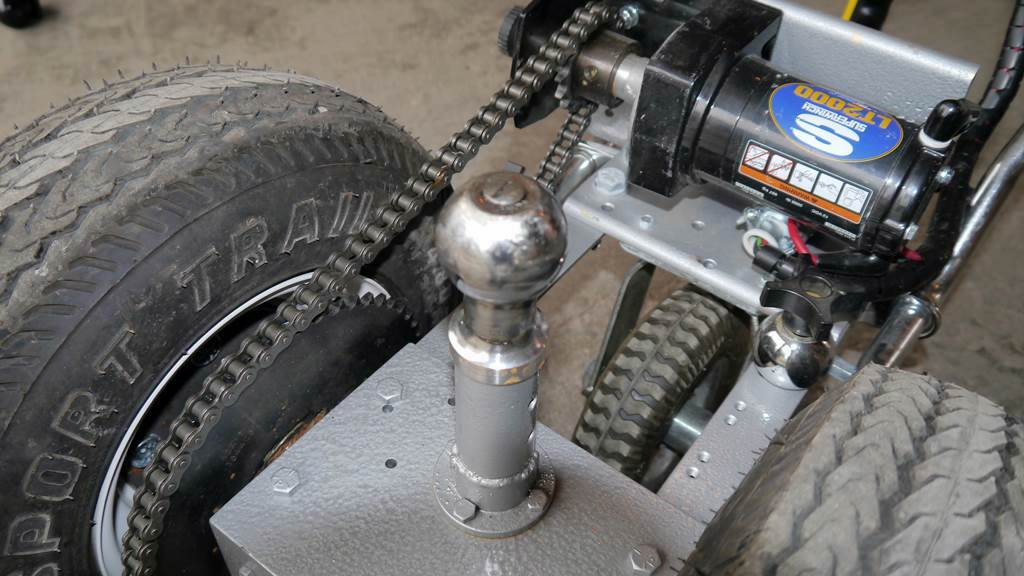

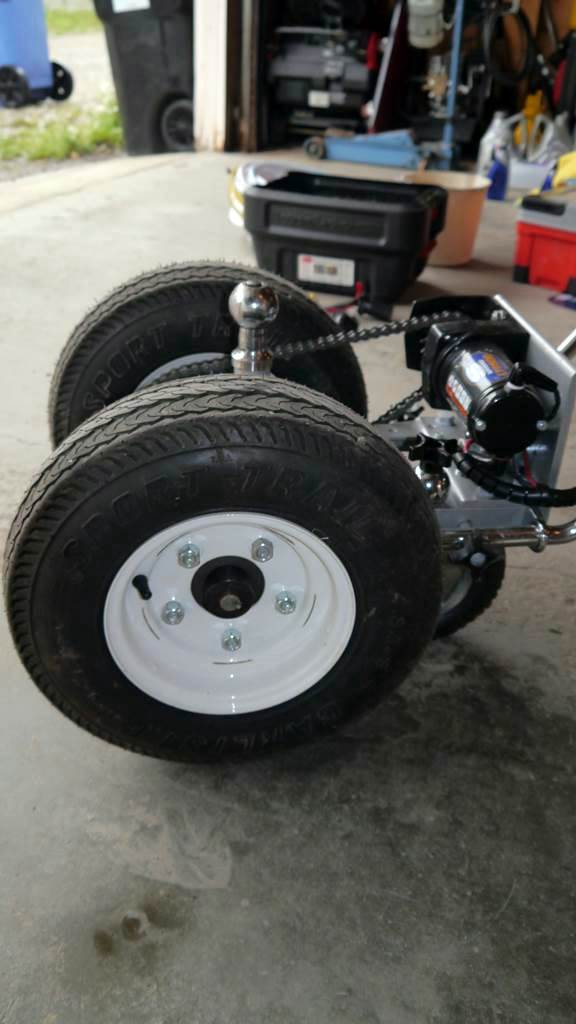
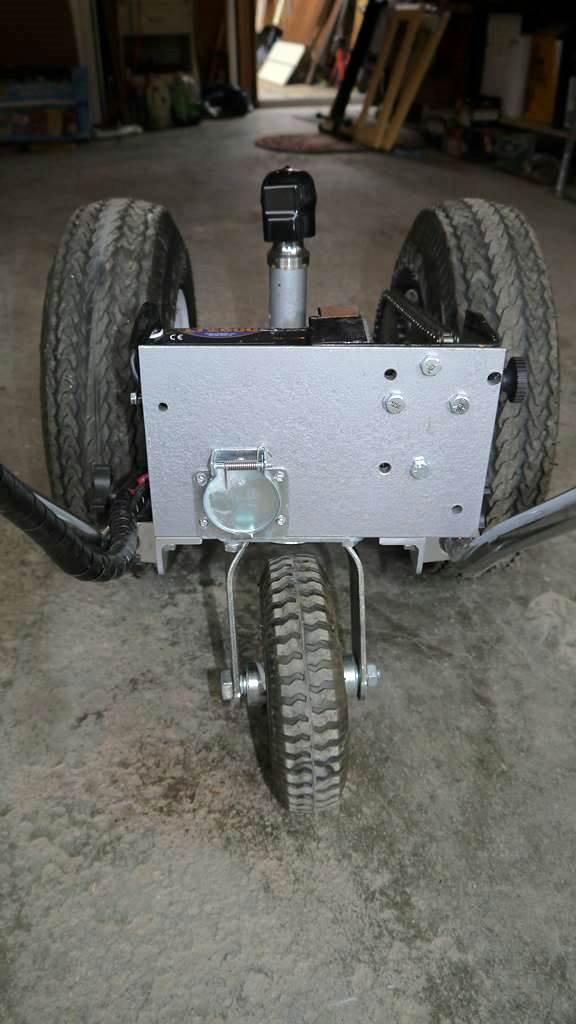
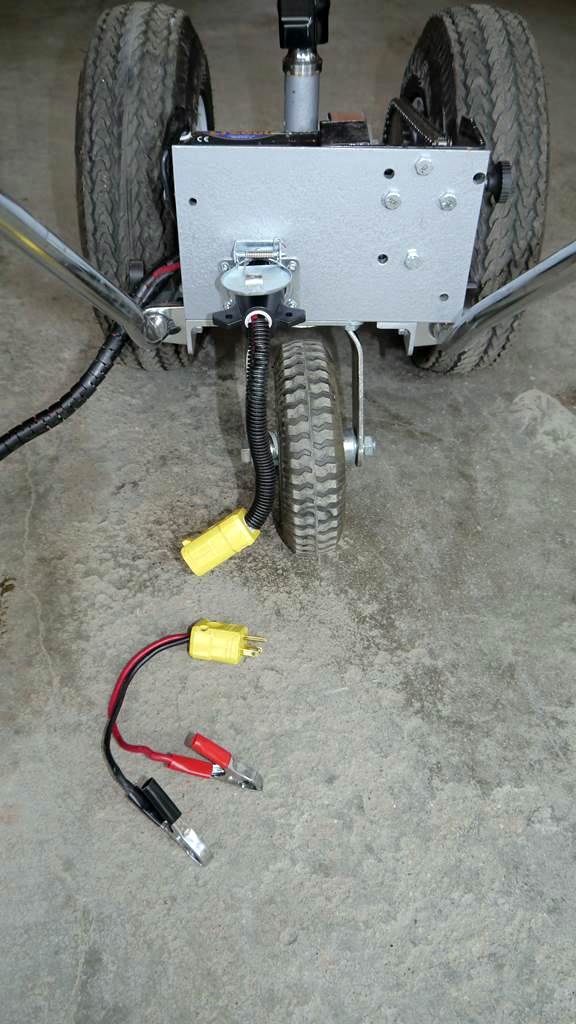
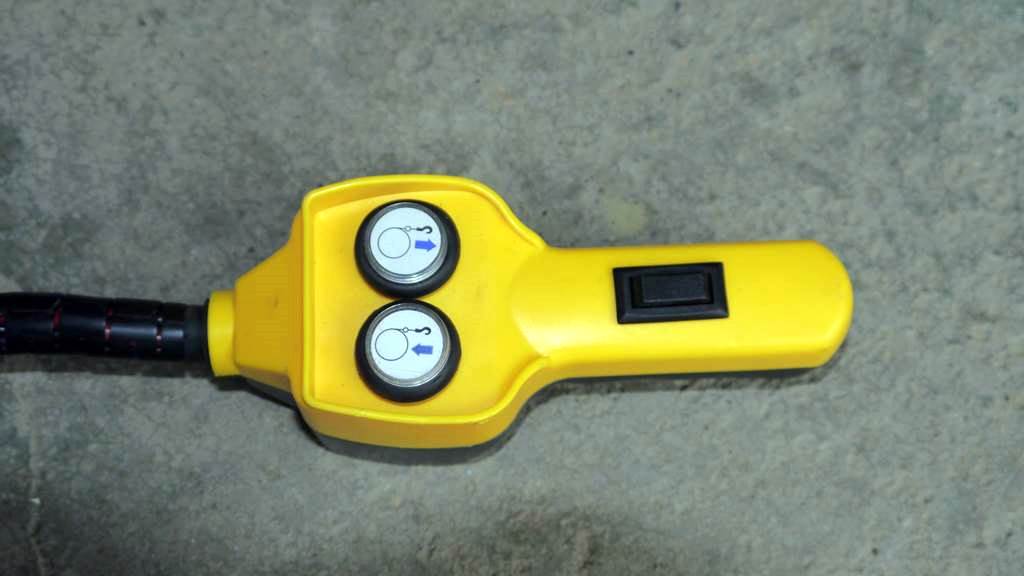
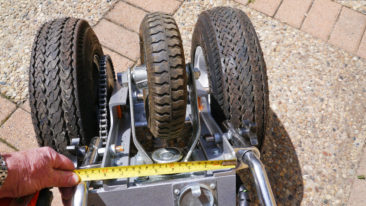
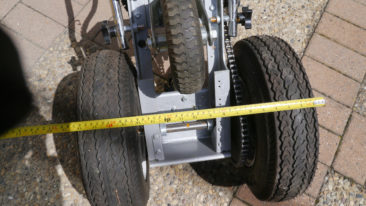
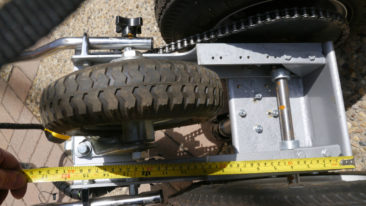
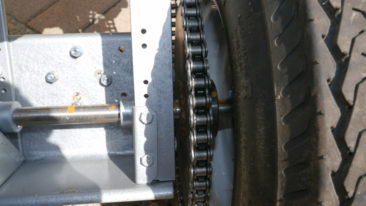
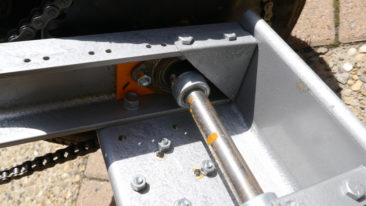
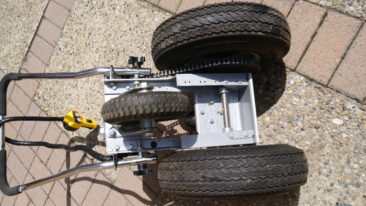
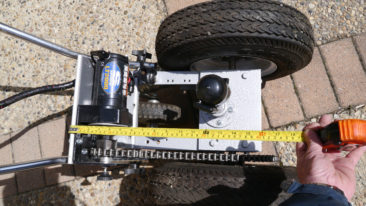
D
I have a winch like the one you used for your trailer dolly project
Can you expand on what you did to get the sproket mounted on the winch.
ID of the sprocket. any machining you did.
Thanks
Ian G.
The rough cast spool has a diameter of about 1 1/8″ where the wire spools and then the larger outer flanges. In a small metal lathe I machined the outer flange completely off and machined the center spool section to 1″, this allowed the 1″ sprocket hub to slide onto the spool it is secured with 2 set screws.
Ed Vervynck
Hi Ian, I am building a trailer tug and I found your version that is exactly what I am requiring. Unfortunately, the underside / measurement pictures are not able to download for some reason. Anyway u could email me or repost?
Thx
Ed
Salmon Arm, BC
Ian G.
Picture have been reloaded, sorry for the delay
jim
do you drive both wheels or just the one side where the sprocket is, if so is there any side whip on the handle when it starts to move? If you drive both wheels, how does it steer while you are moving, very well?
Thanks
Ian G.
Thanks for the note Jim
Both wheels are driven, I did try a single wheel drive in an earlier version but encountered two problems, one is like you identified with it always wanting to pull one direction, the second was that with a single wheel traction was a problem and the single wheel just spun.
Driving both wheels works very well, I am not a big person and have a bad back so it would not be any good if I had to fight with it. To turn the trailer light side pressure on the handle results in a nice gradual turn, for sharper turns a quick tug to set the new direction. In general you just need to guide the dolly
jim
I was concerned about the turning with a live axel, but it sounds ok. I had even thought about putting in a lawn tractor differential, but it seems not necessary.
Thanks
Rick
I notice that it appears you have removed the 2 stabilizing bars/bushings on the winch – I’m wondering if you have noticed there is any flex/twist in the winch under load, or is the casting sufficient since the loads of chain drive are different that that of the loads incurred in use as a winch?
Ian G.
Hi Rick
I didn’t remove any of the bushings or stabilizing bars, these are all essential to maintain the integrity of the winch. The winch had to be disassembled to remove the spindle so it could be turned down on the lathe to fit the drive sprocket, then the winch was full reassembled as original. The drive sprocket size was chosen so it would fit within the winch frame. I hope this explains it better.
Ian
Have you got sizes on the frame work? Width of frames etc… Thanks great idea and looks like it will be a great project to build.. Thanks for now…
Ian G.
Thanks for the comments, it is a great project.
I just posted pictures of the bottom along with measurements
D
Can you post a picture of the bottom? Also would you tell me a little more about the 3/4″ flange for the axle sprocket / where I can find one?
Thanks
Ian G.
Hi D
I purchased all the drive components from Princess Auto here in Canada, if you are from the US give Harbour Freight a try as they are similar stores, in the links below are the sprocket and hub I used.
Axle Sprocket
Axle Sprocket Hub
I will post some pictures of the bottom shortly.
Alain Gilbert
Did you ordered the chain at Princess Auto as well?
Ian G.
Yes I also bought the chain through Princess Auto, the chain is standard #40 chain
D
Thanks for the pics. Those looks like parts from a 2 post network rack. Do you feel you got the gearing pretty good or would you change it ? (I think my trailer is is about 2k pounds or so when fully loaded.
Ian G.
The gearing is good, although I like it being too slow vs being too fast. The only thing that limits the power is the current draw and the size of the power wires. For a heavier trailer you may need to fabricate a shelf on the back to have the battery right on the power dolly or use larger cables so the winch motor can draw the current it needs for the load
Woody
Ian; Man! what a great trailer dooly U build. I have several old jalopies, (29 to 47) in behind my shop as well as some I’m working on in the shop. Moving them around takes some doing, often times requiring a helping hand. I usually grab some teenagers walking home from school. I thought about modifying my riding lawn mower with a tire mounted to the front for that purpose. Well along comes U and your wonderful dolly. I will try and build one as yours to suit my needs.
Bob Wills
Ian G.:
Thanks for the interesting, informative blog and articles; particularly, the DIY Power Trailer Dolly.
A boat/trailer will be carefully parked in a part of our driveway later this fall.
The design represents thoughtful layout; specifically, the ball post being offset a couple of inches towards the small wheel providing a weight distribution to both the traction wheels and to the castor wheel.
Thanks for sharing your classy project design — we will have one of the ‘Proud-Canadian’ DIY Power Trailer Dolly applications here in Washington State.
Thanks again,
Bob Wills
Ian G.
Thank you Bob, appreciate you comments.
Dan Burgess
Found your DIY trailer dolly on the net. just as I was looking at building one. I have not been able to find the 5 on 4.50 hubs to fit tires and wheels I have on hand. Can you point in the wright direction? Thanks Dan
Ian G.
Hi Dan
These are a 5 bolt drive plate that are welded to a weld hub.
Here are the links to the supplier I used
http://www.princessauto.com/en/detail/5-bolt-drive-plate/A-p2080315e
http://www.princessauto.com/en/detail/3-4-in-w-series-weld-on-hub/A-p3845179e
Hope this helps
R Angell
Heck thats better built than a Parkit360 power dolly
Ian G.
Thank you, appreciate the comment 🙂
Craig
Hi Ian
Did you need to put in a chain tensioner to keep the chain tight?
Great job, love it!
Cheers
Ian G.
Thanks Craig.
No you don’t need a tensioner, the slotted base on the winch allows you to adjust the chain tension and then lock it in place. Because it runs at such a slow speed and the chain is so large chain adjustments are only required occasionally.
Craig
Thanks Ian
2 more questions. Where I am from (Australia) its hard to find these small hubs. How would I go if I just welded the sprockets onto the axle and winch shaft? is it likely they will wear out in a hurry?
And what size sprockets/chain are they ? Are they like for a pit bike, or a small motorbike or something else? I see the number of teeth is listed but that doesn’t totally tell me the size
Cheers
Ian G.
Hi Craig
The sprockets would be similar to a pit bike and yes you could weld them to the shaft, it would just make repairs more difficult, wear I don’t see as an issue, they don’t move fast or for any distance.
The sprockets I used are for a #40 chain, 16 tooth #40 drive gear and a 54 tooth #40 driven gear. I am sure you could locate a supplier, a quick internet search and I found this company, although I don’t know how their prices compare or how close they are located to you. http://www.chainanddrives.com.au/products/sprockets
Herb Sorer
Thanks for posting your project I found it interesting. I was wondering if you could tell me if it would be powerful enough to move a 26 foot holiday trailer I cannot remember the weight right off hand, but it would be on level ground. Best guess would be appreciated thank you.
Ian G.
I am confident the unit has the power but you would need “outrigger” wheels at both the front and rear to prevent the dolly level when pulling or pushing, you probably could not apply enough weight or pressure on the handle.
siva
good good
ian McLeod
I built the mover and it works great. I added a switch (push/pull) wired into trailer plug so that I can apply electric brakes on the trailer as well. Also a did a cut out for trailer hitch jack (some jacks mount cause problem) just cut out a place for split piece 3″ pipe which allows unit to fit around jack of trailer tongue. All other it moves trailers with no problems. Thanks for design was well worth the time to build.
Ian G.
Great to hear you build worked as good as mine does Ian.
I can see where some trailer jacks would get in the way, good modification for this on yours (Y)
The rocker switch on my control applies the trailer brakes, an excellent safety feature.
Serge
Good morning Ian! I’ve been following this page for some time… great information and great answers! We’ve recently purchased a 24′ ~4500lb travel trailer. We have a spot at home for it but considering the length of the tow vehicle… well, you know the rest.
What would your thoughts be on using a snow blower as a tug? By unbolting the impeller/auger assembly, you’re left with a nice, powerful drive unit. A steel frame including heavy casters and a support ball could be bolted on and voila! The problem I see is that the tongue weight would have to sit mostly on the forward casters, maybe slightly back (1″) to allow the drive wheels to bite and not spin. Steering would be very difficult.
My apologies if this question diverts the attention from this great build!
Ian G.
Hi Serge, a snow blower could work, but ….
It would be important to have the tongue weight as close to the center line of the drive wheels as possible for both steering and traction. On my initial prototype I used one drive wheel and 2 casters with the ball centered and the traction was very limited, the drive wheel would slip even on pavement. Also, most snow blowers use a friction disc design in there drive system which will also slip if too much load is placed on it, I suspect it would slip unless it was in excellent condition. If your snow blower uses a hydro-static transmission that would probably work very well.
Serge
Thanks Ian!
It does indeed have a hydro-static transmission but the more I think on it, steering would not work very well from the rear drive wheels, At best, the ball would have to sit 8″-10″ in front of the drive wheels due to the height of the trailer tongue. Realistically, the trailer could weigh 5000lbs if loaded. That’s a lot to ask from one snow blower wheel. I think by biasing the weight mostly on the front casters, I would be able to manually slide the rear of the snow blower side-to-side using the handles as leverage. Or possibly, adding a drop-down caster at the back to roll the blower side-to-side, based on the direction I want the tongue to go. Geez… that’s not sounding very good either.
BTW… great work on the Boler! It’s that kind of customization that gets me excited about bringing our new (to us) camper home.
Dean
Ian, thank you for posting this information – very informative.
Question regarding the speed of this trailer dolly. How fast does it travel (e.g., ft/min) with no load on it? and when there is a moderate trailer load (say a trailer weighting 4000-lbs)?
Also, when you toggle the motor on with it connected to a trailer, does the dolly want torque forward and attempt to lift the back end of the dolly do to the lever arm between the coupler ball and the dolly frame?
Thank you for your time.
Respectfully,
Dean
Ian G.
Hi Dean
I calculated the speed way back when I calculated the gearing but don’t have that info currently.
As a guess about 25’/min.at no load
Loaded maybe down to 15’/min. Not fast.
Yes the handle will torque when in motion, for me this has never been a problem and I am not very big.
Dean
Ian,
Thank you for the response to my questions. Based on my quick calculations, I surely agree with your estimated speeds. In your opinion, does the LT2000 provide enough power to readily move a 4000-lb trailer? Also, what diameter did you machine down the cable drum to fit the sprocket? and did you pin the sprocket or just use the set screws?
Again – thank you sir.
Dean
Ian G.
I would say the winch size would also depend on the terrain you are travelling over, on flat or slight incline the LT2000 is sufficient but for more rugged terrain a more power would be beneficial. Another option would be to use smaller diameter and wider tires, this would slightly increase torque, reduce speed and turf tires would probably on areas traction on surfaces that are not pavement
Dean
Ian,
Thank you for the quick response to my questions – you have done a heck of a job with the dolly! I think your estimate on the no-load speed is pretty darn close. Based on my calculations of the drive motor gear reduction (153:1), primary drive chain gearing (16T to 54T) and tire size (~16.2″ diameter), I come up with ~29’/min. I can design out some of the torque issue by pushing the hitch ball an inch further toward the front, but not too far back to place too much load on the front castor.
Do you find that the LT2000 winch motor has enough giddy-up for the trailer loads you are using it with? Also, what diameter did you machine down the winch drum to fit the 16T sprocket?
Again, think you for your time in responding to my questions.
Respectfully,
Dean
Eddie
Ian you are the man! Question, how long can a winch run continuous without having the motor heat up on you? Like making a powered wheel barrow, utility cart, or moving a pallet with wheels filled with drywall panels to the next parking deck? Eddie, (Aloha from Hawaii)
Ian G.
All the uses I have made have not been too far, basically moving the trailer(s) in and out of stalls or maybe 50-75 feet and no heat was generated worth mentioning
Ryan
Hey Ian, I’m thinking of building a dolly like this but with a little but bigger winch, I’m just wondering how heavy of a trailer you’ve moved with yours? I’ve got a travel trailer that’s a little over 5000lbs and am wondering if I’m going to have any problems being able to move it. The winch I’m using is rated for 3000lbs
Ian G.
Hello Ryan
My trailer is around 3800 lbs. The winch size is really based on the gearing, a larger, more powerful winch would be able to keep the same gearing I used and maintain the same speeds (based on the larger winch had the same initial rpm). Gearing lower a smaller winch would have the torque at a lower speed.
William Wooden
Ian G
You have inspired me to build one. Still building on it and hope to have it finished, that is if I stop adding stuff to it. You can view the what I have done so far on Google+. Just type in William Wooden.
Ian G.
I checked out your video William, well done.
Andy
I have the superwinch 2000 and the release knob does not seem to come off. Is it threaded?
Ian G.
Yes mine just unscrewed, although it is also very tight and will take some effort
Al
Ian,
My loaded boat trailer is just under 6000 lbs.
My question is would the 2000 lb winch with the 16 tooth #40 drive gear and the 54 tooth #40 driven gear be able to handle my 6000 lb trailer, or should I use a larger winch?
Thanks
Al
Ian G.
I think that would really be beyond the limits of this design, the problems I see are the poser of the winch but probably more problematic is the tongue weight, you would need swivel stabilizers both front and rear to prevent the dolly from flipping up under power. My heaviest trailer is about 3500 lbs
Dean
I have a 4,500-lb boat and trailer for which I designed my trailer mover for after advising this blog. I used the 3000-lb class winch on mine and use a 16T-40 on the winch and a 40T-40 sprocket on the drive axle. The power and speed are good for moving my trailer; however, I have had to place counter balance weights (~20-lbs) on the front of the dolly to keep the torque from popping the front swivel tire off the ground when I move the trailer forward. I am right at the maximum for tire traction with the dolly especially if there is a slight incline to go up.
Ian G.
Great information Dean, Thank you for your experience and modification for a larger version.
Kerry Groebs
Ian,
Thanks for all the info on this great project. I am currently sourcing parts to build one and have a question. I know you have an adjustable ball height capability. What is the effective range on your ball height? I am trying to decide how to mount the axle, whether like yours or with pillow block bearings mounted to the underside of the u-channel which would raise the overall height by about 3 inches. thanks Kerry
Ian G.
Hi Kerry, actually although the ball size can be changed the ball height is fixed. I think I have it set at between 18″-20″
Vasilis Caravitis
Hi Ian,
Today I tried a modified triple-wheel (per side) cart intended to lift loads up stairs. I had replaced the triple-wheel assemblies with regular car wheels. The boat trailer (with the boat on) would not move, as there was not sufficient traction and the wheels would just spin.The trailer nose load (aprox. 40 kg) was not resting anywhere near the wheel axle but approx. 50 cm in front. I presume that this, combined with the large diameter of the car wheels (~50 cm) made traction to fail. Based on your experience with trailer dollies, would you make a guess on what may have gone wrong? Approximately what weight to rest on the wheel axle would be required? I could email you a photo of the structure so you can give me your opinion, if you send me your email address. Thanks.
Ian G.
I agree with your theory. The first version I made actually used one drive wheel and 2 swivel wheels and as yours it would not get any traction. The trick is to place as much weight on the drive wheels as you can, the idler wheels are just there to prevent the dolly from flipping.
Kerry Groebs
Ian,
Thanks for the reply. Do you find any torque problems on the ball mounting plate? Seems to be relatively small base with a relatively long lever arm to the ball. I am wondering if this has been a problem for you. Thanks Kerry
Ian G.
I have not had any problems but the heaviest trailer I am moving is about 3000 lbs
Kerry Groebs
Ian,
Thank you for the reply. Sorry I have another question. The drive hubs you used form Princess auto I looked up and cannot find the size of Keyway listed. I called princess and talked to a customer service rep and he could not find that dimension either. can you tell me what the Keyway size is for that 3/4″ bore w series hub? The 3/4″ axle stock I ordered has a 3/16″ keyway and that is what I need for these hubs to work. Thanks so much for you help.
Ian G.
Yes you are correct, the 3/4″ axle shaft uses a 3/16″ keyway. http://www.princessauto.com/en/detail/3-4-in-x-3-ft-keyed-shaft/A-p8079733e
Kerry Groebs
Ian,
Thanks for the reply. I can assume then that the W series hubs, that you used from Princess auto with 3/4″ bore are also keyed for 3/16″ ? Is that correct? Sorry for all the questions. Just don’t want to order parts that will not work. Thanks again. Kerry
Ian G.
Yes that is exactly the items I used
Good luck with your build
Nathan D
Hello Ian! Awsome build! Thank you for the fantastic photos ect! Do you by chance have a wiring diagram? (Specifically the trailer brake circuit). (I assume your just applying the full 12
Volts when the switch is on?)
I was going to build this exact unit, but I recently found a deal on a Park it P360L on kijiji. I can also attest that your build looks as skookum or better than the park-it! So far it works well, but I would like to add trailer brakes to this unit before I attempt my slightly steeper front driveway because; safety!
Thanks again, nice work!!
Ian G.
Thanks Nathan
I appreciate your comments
You are correct that the brake wiring applied full 12V to the trailer brakes. Just tap off the 12V+ in the hand control and wire down to the Brake power terminal in the plug, make sure the negative terminal in the trailer plug is connected to battery neg(-).
Dennise
Dear Ian,
Can i use Electric-Lithium battery to supply power for this dolly?Also i am about to start this project on my own,could you please let me know some idea of price for this complete product? kindly let me know what was the final weight of your product?
Cheers
Ian G.
Hi Dennis … sorry I cannot help you with your question on using a lithium battery, I would check with a battery special shop to see if it will work with the current draw needed by the winch.
I really never kept track of the cost and I built it about 3 years ago. Prices on parts will also vary depending on where you live. I bought most of my parts through Princess Auto here in Canada but I would imagine Harbour Freight in the US should also have similar parts.
Dennise
hi Ian,Thanks for the quick response.could you please let me know what was the total weight of the unit?
mike
Great build! I’m am in the process of gratefully copying your dolly and just have one question, on the front of the dolly. there are 2 bolts on either side on the vertical face of the aluminum angle, what are they securing? or attached to? Thanks again, great job!!
Ian G.
If I understand you correctly those bolts are securing the winch to the rear vertical member.
Don
Great job.
I want to make a power dolly to move our 4000lb go kart trailer around the yard. Where I have to park it is a hassle on the back of an extended pickup. How long do you think the unit will run on a full charge? I’m thinking I’d also like to make something dual purpose to also pull all the ice fishing gear out onto the ice. Can’t afford an ATV or snow machine at the moment.
Cheers
Don
Dave
Ian, I have been looking for a decent trailer mover for a while, your design is simple effective and well made,nice job. I will be fabricating one this weekend . Thanks
JohnPaulyMath
I am building an invention right now, which I call the R2W or RoboRoverWheel.
The 5-Bolt Drive Plate is exactly what I need to turn a single ATV wheel into a live-axle traction wheel.
Thanks for posting this project, and answering all of the questions so thoroughly.
Where are the winch mounting-slots located, so that you can tension the drive chain? I don’t see them in the photos.
I’m from Canada as well, and my last invention was a crane, which I built from scratch. You can take a look at it here on my blog: http://www.localsonlycanada.ca
Jack
Ian,
I have been looking for an powered trailer dolly for a while, your design is simple, effective and well made, thank you. I’m intending to build one myself.
I’m after the images that were of the under side of your power dolly with the measurements, that were previously on this page still available? Is there any chance you could provide me with a link to access them as the existing ones will not load up. Kind regards Jack
dimentions
Ian G.
Sorry Jack, I had a database crash and lost those pictures for a while but I have reloaded them again
Clark
Is anyone that built one interested in building another for sale to myself?
Mark
I think I would like to build one of these units, what is the length of the 3X4 angle for the front and back ends, and was the adjustable tow ball purchased at Princess Auto.
Hope mine turns out as good as yours!
Thanks
Ian G.
Sorry the pictures with the measurements disappeared for a while, but they are up again at the bottom of the page
Brian Lanktree
I need to build such a unit to move an 11,000 lb 5th wheel RV with a hitch weight of about 1100 lbs.
Has anyone built something similar to this great unit but with a high capacity? In looking at winches at Princess Auto the Warn 4000lb winch appears to be adequate.
My concern would be to ensure the unit has enough power to get through gravel in the spring (perhaps a bit soft)
Great project you built here. Hats off to you.
Ian G.
Hi Brian.
I would have huge concerns moving that size and weight using this design. I would probably look at something that the landing gear sits on to keep the weight as low as possible, the challenge will be to design a steering system that you can turn with that amount of weight
Bob
Great to find your website. The big thing was the gear ratio… it works great. Built one similar to this and moves my trailers without a vehicle. Have two mobile wood fired pizza ovens which are heavy… and yes like you I AM CANADIAN… thanks bob
Chris
Hi Ian. Thanks for this post. This is really cool. I work for a small boat yard here in Maine and my boss asked me to research powered boat trailer pullers. I found this video https://www.youtube.com/watch?v=OF7T7lorKeI on YouTube and contacted the company (http://www.ergonomichandlinggroup.com/ ) because they were in my area. They gave me a price of $7,700 for a commercial one! I want to see if my boss will let me make a few of these instead of buying one. Can anyone here give me a cost estimate of one you built? Thanks. – Chris
Ian G.
I think the total cost for me was around $300
John Heidenreich
Hi Ian just saw your Power Trailer Dolly and am very impressed. I live in North Tasmania and would love to have a go a making one for our son but I am right out of my depth. Is there any way you could possibly send me some easy to follow plans? With some explanations beside some of the more technical words? I am so happy to pay for any plans…as long as they are not too exorbitant!! Congratulations of what seems to be a really nice little Dolly.
Kind regards and God bless for the New Year.
John
PS. My address just in case you can forward me some plans is: 48 Upper Natone Road, NATONE. TASMANIA 7321
Ian G.
Hello John. Thank you very much for your message. As I approach retirement I may have the time to write detailed plans for the Trailer Dolly, unfortunately right now there are just not enough hours in a day to get everything done I need to do or want to do.
Ed Vervynck
Hi Ian,
I also am very interested and can figure out most just from the pictures. In one of your threads you mention that you attached pictures of the bottom section of the dolly but for some reason they do not show. Can you repost again or email me them directly?
Great project!!
Ed
Salmon Arm, BC. Canada
Ian G.
Sorry about the missing pictures, I had a database crash and I am working on re-posting all the missing pictures.
I will try to get them re-posted within a week
Ed Vervynck
Thank U Ian.
Ed
Ian G.
You are welcome
The missing pictures have been added
Ed Vervynck
Thank U…Perfect!!
Ed
Clark McFadden
Ed, if you are going to build one, I am interested in seeing final product. I want one although cannot build and am looking for someone to build one for sale to myself.
James
Ian,
Really like your Build ! I’m wanting to construct a unit very similar to yours but will need a lot more power for my application….thinking of a 9000 to 12000 lb winch, but unfortunately just about any winch over 2500 lb has the motor on one end and all the gearing on the other with a pretty good size diameter drum in the center. Got any suggestions on how to do a power take off with those, or a different direction than a winch….I do need a forward and reverse and love the straight forwardness of your design. Any help would be greatly appreciated.
Thanks, James
Ed Vervynck
Clark,
Sorry, but I am not looking to build and sell….only for myself at this point.
Ed
Patrick Bryson
I have been wanting to build one of these for a while now your plans are really good I have a thirty foot Bullet Premier dry weight is 6800 lbs loaded is 8200 lbs. what size of winch motor do you think i should use and gear sizes. also figure if i install a pipe with a large steel ring welded to the top with a small hyd. jack on top of the base it would stablize the the ball in the hitch and stop the dolly from doing wheelies from the tourque of the wheels
Ian G.
Yes Patrick with that size of trailer you would need a larger winch (no idea what size), the battery connected directly to the winch and a sleeve type coupling to prevent the dolly aligned
Stephane
Good morning to you, I wanted to know if you have a unit that operates at walking speed, also if the unit can be automated with a stand alone battery, I just need a unit that has a capacity of 800 lb. Can you quote your product including shipping.Thanks
Ian G.
Hi Stephane
I don’t make or sell these, I am simply sharing my design for anyone who wants to build one for themselves. The design is easy to modify the unit with a variety of winches which could increase the power or load capacity and you could build a tray to contain its own battery. Good luck with your build.
Noel
Hi Ian, I am also building one as well. Just wondering, did you have a keyway on the drive sprocket on the winch or just setscrews to hold it please mate.
Ian G.
I used a longer set screw and drilled the shaft to ensure it would not slip
Andy
On mine I used a dremel tool to cut a half moon shaped keyway into the winch drum. I did the same thing on the axle.
Ian, thanks so much for posting this. It was a great project.
Noel
Thanks Ian. I will post some pictures when I finally get around to finishing it. Hopefully soon as I am getting too old and cranky to keep moving trailers around in the back yard.
John Heidenreich
Thanks Ian for your reply. I’m retired and it IS good to have a bit more time available to “other things”. I understand your lack of time (until you retire!) but is there any chance you could just tell me the dimensions of your dolly…length’ width for example. I am totally new to this kind of work but I want to have a go!!
Kind regards.
John
Ian G.
Hi John
If you scroll down to the bottom of the page there are pictures where I show a tape measure with the dimensions
– Width 8″
– Outside tires 18″
– Length 16″
Hope that helps and good luck with your build
Noel
Hi Ian, On the reduction sprockets you are using, how many feet per minute travel do you get please? Also, in case anyone is interested, I managed to get the rear live axel and wheels off a quad bike for the drive wheels. The advantage is that the hubs are splined to the axels and it already has bearings where the bike frame was bolted on to the assembly. Saves a lot of setting up. I will send some pictures when finally complete.
Ian G.
Wow Noel, you ask good questions.
The winch runs at about 30 rpm without load and about 7.5 rpm under full load. With the sprocket gearing the wheels will turn at about 3 rpm no load and 2.25 rpm under full load. The wheels I am using have a circumference of 50″ which means a ground speed of 12.5 fpm no load and about 9.4 fpm under full load. Not fast but that also makes it safer and easier to control. Having any components pre-made would be awesome, what is the weight of the ATV axle assembly?
Noel
Hi Ian,
I am not sure of the actual weight of the axle assembly but I would guess about 15 to 20 Lbs including the hubs. The only small disadvantage with using the quad rear axle is that the bike mounting and bearing assembly is a couple of inches off set from the centre of the axle. It would be too expensive to shorten one axle and have it re splined. I intend to just make the frame a bit wider on one side to make it look like it is centred. It should not detract from the operation of the unit.
I am not really worried about how heavy it is, the heavier the better really as it will be used on a grass area which is slippery clay under. Also, our back yard is on a bit of a slope, so the heavier it is the better within reason.
The wheels are 53 inches in circumference so using your gearing should work out ok.
Many thanks Ian.
Ian G.
Sounds like a great plan Noel
I use mine at a storage lot where I store my trailers so I needed it light enough to transport in my vehicle and lift by myself
Robert Campbell
Ian, thanks for much for publishing the plans for the trailer dolly. I have obtained pretty much the identical parts I need from Princess Auto and I am in the process of building one much like it. Since I have a full machine shop, I am able to weld anything needed. I am changing things a bit..the base will bea 10 X 24 inch steel 1/4inch plate so I can mount the battery on the base in front of the winch. Modified swivel wheel up front mounted underneath the battery to support the weight up front; ball mount on a customized mounting plate so I can simply change the size of the ball, or more importantly, mount a special bracket to hold a customized mount on the Ranger boat trailer which leaves the boat trailer hitch free of the dolly. This will allow me to move the unit around to position the trailer over the vehicle ball as well. Total cost including the battery will come in around $700, a far cry from the $2000 to buy a similiar Packit360 device (made near here in Carleton Place). If I find the unit moves too slowly, I will simply change the front mounting sprocket to a larger one, since the boat only weighs about 2200 lbs, and the purpose of the dolly is …1…to assist in positioning through a tight fitting carport..and 2- to assist moving it across the grass to it’s parking spot. All the best…
Ed Vervynck
Robert,
Is it possible tho show some pics on this forum also as Ian has done?
Great projects and like you say a huge saving over buying one.
Thx,
Ed
Robert Campbell
Yes, I had planned to do that but only after it is built in final form. As I put it all together in final form, I will take pics and if I can figure out how, I will post them. If I cant, I will email them to whomever wants pics.
Only things left to figure out are the post and ball arrangement and the handle. I’m thinking I will simply weld a couple of 8 inch pieces of steel (8 inches by 3 inches by 1/4 inch thick, with a 3 inch square top piece with a hole large enough to simply mount any size ball. This will also allow me to add some sort of arrangement to attach the unit to some other part of the trailer frame to leave the ball free for manoevering onto the van trailer hitch.The post arrangement will be open on the sides for changing the ball. The handle must be removable for storage and will have the control mechanism cable strapped to it with the control at the top of the handle. I also have to jury rig a rotating wheel up front of the correct size to keep the platform level. The four bolts holding the swivel wheel will also hold the battery box to the platform. Plus all unpainted parts with the exception of the 3/4 axle will be painted black to keep rust at bay using Tremclad rust paint.The two holes used for mounting the winch will be elongated for later chain adjustment should it be needed. Once I see how fast this unit moves in practice, I may decide to mount a larger wheel on the winch to speed up movement using the balance of the 10 feet of chain I bought from Princess Auto (and assuming the winch has the power to do so). In total, the unit will be quite heavy but that will add to stability and the front mounted battery will help keep the unit from rising at the front. If I want to pick it up at any point, I will simply weld handles on each end. The ball will be located about 2 inches in front of the axle frame itself, which should also act to keep the front down while pulling the trailer. That 2 inch measurement seems to be about what Ian used on his unit.
The battery and excess winch cable will be housed in a battery box I bought at Sail for $15. I also bought special battery posts at Princess Auto for $6 that allow me to attach not only the winch cable, but leads for the battery tender that will sit atop the battery box keeping the battery in good health during storage. Both the leads going in and the tender leads coming out, will exit the box through the built in venting ports on the battery box, keeping everything neat and professional looking.
Hope all that helps
Steve McDaniel
Robert,
I wonder if you have finished your trailer dolly? I’m sure everyone here would like to see it. Please post some pictures.
Thanks
Noel
Hi Ian,
Finally finished the monster…I have been very sick for the last couple of weeks with pneumonia so I have been dragging my feet a bit. I hope to have it painted tomorrow, at least the etch primer done anyway. It works well on concrete but when its moving the tinny up the rise in the back yard it loses traction and starts digging holes so I am going to add a couple of hundred pounds of lead on the machine if I can locate some cheap enough. That should stop it wheel spinning. I could most probably sell it as a plough at the moment for use on soft ground !! It really has some “grunt” when on concrete before the wheels start spinning. I put it up against a verandah post and tried it out when I finished it and I thought it was going to collapse it. If I can get it painted in the next couple of days I will post some pictures for you. I have not added all the costs yet but it will definitely be under AUD$ 400 complete but I would think closer to $350. including a second-hand battery.
Regards, Noel.
Noel
Hello I Ian,
How do I post some pictures on here please???
Regards Noel
Ian G.
Hi Noel
You will need to email me your pictures with a write-up on how you built it or what modification you made on my plans I would be happy to add your information to my post.
I tried emailing you but the email was rejected. Send to 1974Boler [at] gmail [dot] com.
Robert Campbell
That is great. I am just coming to the end of my construction of an all steel unit but based on your plans Ian, and modified slightly to better utilize my machining facilities. I will send you along my pictures and layout when done…still have to paint it, but it works brilliantly at very low cost to build. And thank you again for the idea and plans
Steve Emery
Hi Ian, I really like your design and have decided to build one as I am shortly to have a hip replacement. Could you please recommend appropriate sprockets for max speed. I am using 16″ dia wheels with the same winch you used. My trailer and boat combination are on a 750 kg trailer so the weight is not as great as a lot of the uses this design has been put to.
Stephen Skjomsby
Hi Ian,
I just built one similar to yours and it actually had no problem moving a 5000 lb RV. I geared mine a little lower and i have two sets of tires….either 16″ tires or a set of 13″ ones i made with rims I modified to fit a 4 bolt pattern hub. What wiring did you use to wire up the rocker switch to get the trailer brakes to work? I would really like to have trailer brakes on my dolly….its a little scary with out them!
Ian G.
For the trailer brake you just need to provide 12VDC power to the trailer brake power lead in the trailer plug. It is usually the BLUE wire connected to terminal #2.
The rocker switch will apply full 12VDC to the brake magnets that apply the brakes.
Alain Gilbert
Hi Ian,
I was in Princess Auto today and saw a 8″ pneumatic swivel caster. I was hesitant and finally did not bought it as I wanted to keep the dolly as horizontal as possible and thought that 8″ would be too high. I was looking for a 6″ but did not found any. What size you used?
Ian G.
That’s a really good question, I will have to check. If you have your drive wheels you want the caster height to be about 1/2 their diameter, with the mounting plate about 8″ above the ground, I am guessing mine is a 5″ or 6″ caster.
Kevin
Great build! Is the motor shaft able to be separated from cable drum? I don’t have the ability to machine the drum down to a 1″ shaft, could I use the motor shaft as is instead by using either a keyed hub or welding the sprocket to the shaft directly?
Ian G.
Yes the drum unit does separate but unfortunately the drum is an integral part of the planetary gear reduction so there is no shaft coming off the motor
Alain Gilbert
Hi,
I am designing mine based on the scap metal available so I still have time and room for improvement.
I am hesitating between installing 1 or 2 swivel caster wheels.
– Have you or anyone on this post used a 2 swivel caster weels design.
– Why have you choosed 2 swivel caster wheels over 1 or vice-versa.
– If one has made and tried/tested both designs, which one you prefer and why?
John Heidenreich
Hi Ian my dolly is coming along well. Just discovered it’s rather difficult to turn with both wheels fixed to the axle but with no acute turns it should be ok. Reading your block is most helpful. Thanks. Glad to say mine is actually looking much like yours. 😀Been a thoroughly enjoyable exercise! Just hoping it works!!
Kind regards
John Heidenreich.
Tasmania
Ian G.
Yes, that is one reason to keep the wheels closer together, my first version only had one-wheel-drive it turns easier but didn’t have enough traction, the one wheel just spins.
Robert Campbell
I have found that I have to modify my dolly to make it more stable. It seems that with two wheels at the rear and only one at the front, it tends to tip over. So I plan to make it a four wheel dolly to add stability. Also I have found that the trailer ball should be about 4 inches in front of the axle (rather than 1.5 inches), so I will have to move the ball mount forward. However, in spite of these needed changes, it has an amazing amount of pulling power and will pull a 3000 lb boat over rough lawn with no effort.
Ian G.
I agree that a caster in front and behind the drive wheels would make it much more stable (my trailer is lighter so this is not an issue). Only caution is to keep the ball as close to the drive wheels as possible. The further you have it away the more weight is transferred away from the drive wheels and onto the caster. You want as much weight on the drive wheels for traction. I would add casters on both sides but mount them so they are slightly off the ground to have full weight on the drive wheels.
Robert Campbell
Yes, the position of the ball relative to the drive wheels will likely take some experimentation. I did find that with a heavy boat trailer, with the ball positioned 1 inch in front of the axle, that the dolly tended to lift the front up when the trailer wheels met an obstruction on the ground surface. So perhaps 2 inches in front of the axle would be best.
Problem is, to move the mount I have to cut it off with my plasma cutter and re-weld it plus all the painting. Perhaps what I will do is make a large mount with several positions for positioning the ball 1 inch, 2 inches, and 3 inches in front of the axle. That way I can experiment to find out which works best based on the weight of the trailer.
Bryan
Hi Ian
What a great idea. Thanks. I have almost finished one. Painted but untried. I think it will work. All the best for your new bright ideas.
Vasilis
Hi Ian,
I have built a similar type dolly with similar type tires (diameter 40cm, width 8cm), but the traction on gravel/dirt terrain is not sufficient for moving the trailer. The only weight directly of the wheels is the 60AH battery (the trailer hitch carries minimal weight). Did you try yours on such soft terrain? I am currently considering of replacing the tires with tractor type such. I have thought of slightly deflating the tires. Possibly adding snow chains. Any experience on such aspects? Thanks.
Vasilis Caravitis
Hi Ian,
This year I built another, dedicated, dolly. Motor power (350W) is sufficient, but traction, again, is the problem. Most of the terrain I would move the trailer on is dirt with gravel and the weight of the 60AH lead-acid battery directly on the axle does not seem to be enough. I changed the tires to tractor type, 40cm in diameter and I have thoughts of adding dead weight (a container with lead blocks) to increase traction. Have you ever measured the load per wheel or the total on the axle that will give sufficient traction?
Ian G.
On some terrain I also have tire slip issues. A narrower lug grip tire will exert more pressure on the ground, you could definitely also try lowering the tire pressure which should help.
Roger Lower
Hi I am thinking of building this for maneuvering my trailer at home on my driveway. My trailer is 4000 lbs and my driveway has a slight grade (about 1 in 10) at the bottom end. Do you think it would handle this ???,
Thanks,
Roger
Ian G.
I move a 4000 lb tandem axle trailer with mine. It has enough power but the current draw is considerable so I would recommend having the battery attached directly to the mover or use large cables to supply power
andy greene
This is fantastic. I’d like to build one with a wider chassis to accommodate a deep cycle 12 volt battery as my sailboat I need to move up and down a slight grassy incline has no onboard power.
Gilles Boily
Bonjour quelle est le prix
Ian G.
This is information on how I built my power trailer dolly. I don’t make or sell these, it is a DIY project
Ce sont des informations sur la façon dont j’ai construit mon chariot de remorque électrique. Je ne fabrique ni ne vends ces derniers, c’est un projet “faites-le vous-même”
charlie
hello can you help me out here i am building caravan dolly like yours but can you help me out with the wheels you got for your one can you tell me size for your or point me in the place you got them from thank you
Ian G.
The wheel / tires I used are 4.80-8″ which have a diameter of 16″. They are mounted on 8″ rims with a 5×4.5″ bolt pattern. You can use any tire rim combination that will result in a tire diameter of about 16″ and where you can get hubs that fit your axle and rims. A more common small trailer rim has 4 bolt on 4″ spacing. You appear to be in Australia so here is an example http://alinetrading.com.au/product-catalogue/wheel-and-tyre-assemblies/trailer-wheels-and-tyres-8-12
Terry
Great project. I am going to PA next week to grab the parts. Are you wheel hubs welded to the 3/4″ Axle or how are they attached.
Ian G.
The axle has a keyway cut into it, the wheel flange is welded to the hub, and the the hub assembly is located to the axle with the keyway and set-screws
Eric
Is the axle a live axle or single wheel drive
Ian G.
It is a solid axle. Both wheels are driven